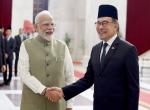North India was under Greek rule in the form of a colony, whose Governor General was Seleucus Nicator. India was divided into little principalities or Janpads of which Magadh in modern day Bihar was probably one of the most prominent. Magadh had a sage, thinker, a political philosopher called Chanakya, also known as Kautilya, who had left Magadh for Taxila or, as it was then called, Takshashila, because he was persecuted in Pataliputra, the capital of Magadh. Presumably out of a feeling of revenge, but mainly because Chanakya was a great political philosopher, he took as his shishya, or student, one Chandra Gupt of the Maurya clan, whom he groomed to become the ruler of Magadh. When he succeeded in this, he proceeded to teach Chandra Gupt Maurya the art and science of government.
Chanakya well understood the need for a strong, unified, well organised state as essential to the integrity and security of the nation. Forcing the Greeks out of India was a matter of the highest priority, but Chanakya did not allow his student and young master, Chandra Gupt, to act impulsively in the matter. He advised him that for Magadh to be strong, it was vital that he bring all the Janapadas of Northern India under the umbrella of Magadh and then as a unified nation wage war on the Greeks. His strategy worked beautifully, Seleucus Nicator was defeated and Greek domination over India ended. The lesson for us modern day Indians is that only if India is strong and united can it unify and prosper as a nation. Otherwise, with its heterogeneity, its diversity, India can and in the past has broken into small units, thus making the nation vulnerable to foreign invasion. Successive waves of invaders, the Shakas, the Hunas, the Kushans, races of Turkic, Afghan, Mongol, Uzbek and Persian origin as also Anglo Saxon invaders have conquered India not because they were strong but because we were divided and weak. We also have a long history of treachery locally for personal gain, whether it was Ambi who sided with the Greeks against Porus, Jai Chand who sided with Mohammed Ghori against Prithviraj Chauhan, some of the rulers of Rajasthan and Gujarat who sided with Mahmud Ghazni in his attack on the holy shrine of Somnath or Mir Jafar, who sided with Robert Clive against Siraj-ul-Daulah. It is these traitors who have delivered a weak India to a foreign invader. The hidden Mir Jafars today include those who plead that Kashmir should be allowed to seek its destiny outside India, advocate that if the North East wants to break away why stop the people and even support Naxalite terrorism on the grounds that after all they are only protesting against what they feel is an unjust society. Now added to the list is those who use violence as a means of the creation of new States, of which the latest example is Telangana.
India has a long history of conflict between the concept of a nation State and the exact opposite which is fissiparous and which tends to divide. When the Centre becomes weak the constituent units first become autonomous and then eventually break away. That is what happened with the Mauryan Empire, the Gupta Empire, the Mogul Empire and, eventually, the India which the British had united and which they now vacated on 15th August 1947. In the Mogul Empire, for example, so long as the Emperor was strong, the Subedars (Governors) behaved. When there was a perception that the Emperor was weak, the Subedars began to flex their muscles. Aurangzeb was the last real Mogul Emperor and even during his declining years, the Deccan had begun to show signs of extreme unrest and the satraps had begun to assert their autonomy, if not independence. This is what the later Moguls inherited from Aurangzeb. By the time Nadir Shah attacked India, the Mogul Emperor existed only nominally and the Subedars went their own ways and increasingly the influence of foreigners such as the British, the French, the Portuguese and the Dutch grew. Whereas French and Dutch influence was curbed and reduced to a minuscule because of developments in Europe and the Portuguese never expanded beyond Goa, British control over India grew so much that by the time of the First War of Independence (which the British termed as the Sepoy Mutiny) in 1857, the British were virtually masters of India through the Governor General, nominally a servant of the East India Company but actually the representative of the Crown. In 1858 even that fiction was gone and Britain assumed direct control of the Government of India.
The British rulers firmly put down all regional resistance, made the country politically and administratively unified and established a nation State to which India, Pakistan and Bangladesh are heirs. It is this India minus Pakistan and Bangladesh that India inherited, but with a nascent problem of the possible effect on Indian unity subsequent to lapse of paramountcy by the British before they left. The possibility of declaration of independence by the Princely States was very real and had Sardar Patel not firmly intervened to first have the Instruments of Accession signed by the rulers and thereafter Instruments of Merger which incorporated the Princely States into erstwhile British India, the balkanisation of India would have been complete. Sardar Patel’s vision and firm resolve in action came from his deep understanding of the basically centrifugal, fissiparous tendencies of us Indians in which a firm hand at the Centre maintained both order and integrity of the nation and weakness inevitably led to fragmentation. The strengthening of centripetal forces which unified are evident in different parts of the Constitution, which need not be enumerated here, but it is also a cautionary signal that if these become weak then centrifugal forces will take over and India will break up.
This brings me to the events which have resulted in Parliament voting for the breakup of Andhra Pradesh into the two States of Telangana and remaining Andhra Pradesh. The history of how Andhra Pradesh came into being in 1956 after the reorganisation of Indian States is well known. The Madras Presidency was huge, embracing as it did both the Tamil and Telugu speaking parts of the Presidency and including Malabar District of Kerala. At that time, after the merger of Hyderabad into India, part of the Telugu speaking population of India dwelt in Hyderabad State, mainly the districts which formed what is now emerging as Telangana. Potti Sriramulu, the leader of the Telugu Movement for a separate Andhra Pradesh, went on an indefinite hunger strike which resulted in his death, Jawaharlal Nehru panicked, the States Reorganisation Commission was set up, it was decided to accept language as one of the major factors for determining a State’s boundaries and in the process Andhra Pradesh was born, consisting of the Telugu speaking districts of the old Madras Presidency and of the old Hyderabad State. Hyderabad ceased to be a State, Hyderabad city became the capital of the new State of Andhra Pradesh, the Marathi speaking districts of Hyderabad State were merged into Bombay State and later formed the Aurangabad Division of Maharashtra. The Kannada speaking districts of Hyderabad were transferred to Mysore, now Karnataka. The new State of Andhra Pradesh inherited the rich coastal region and the dry Rayalseema region of erstwhile Madras Presidency and the extreme Left affected districts of Telangana from Hyderabad State.
The Telangana region was highly exploited by an iniquitous zamindari system which existed in Hyderabad State and the misery of the peasant population led to heavy infiltration by extremist Communist forces, resulting in considerable violence. The Hyderabad State Government of the Nizam had banned the Communist Party in 1943 and this ban continued after the merger of Hyderabad with India. V. Nanjappa was sent as Special Commissioner for Telangana and he ruthlessly put down lawlessness in the districts of Karimnagar, Warangal, Nalgonda, etc. This is the area in which Naxalism also prospered, till the Andhra Pradesh Police through ruthless action suppressed it and forced the Naxalites to largely migrate to Chhattisgarh and Odisha. The resources of Andhra Pradesh were of a magnitude such that Naxalism could be handled. This was true of united Madhya Pradesh also and till Chhattisgarh was formed, Naxalism was very much under control. It is only when the Naxal affected areas of Madhya Pradesh became part of the smaller Chhattisgarh State that the problem magnified till it reached its present proportions of almost uncontrolled lawlessness.
What the new State of Andhra Pradesh also did was to enact and enforce land reforms which relieved the peasants of crippling inequality in the Telangana area. Firm police action provided the environment in which government could begin to function once again, but it is land reforms, development programmes and extension of economic opportunities which helped Andhra Pradesh to bring Left extremism under control.
Before discussing the merits or otherwise of the partition of Andhra Pradesh, which must be seen in the context of our history also, it is important to comment on the procedure adopted for passing the Bill regarding the partition of Andhra Pradesh by the Parliament. The formation of new States and alteration of areas and boundaries or names of States is governed by Article 3 of the Constitution. If a Bill is introduced in Parliament in this behalf, it is mandatory for the President to refer the Bill to the Legislature of the State concerned for expressing its views. The Andhra Pradesh Legislature overwhelmingly rejected the proposal, but Parliament went ahead with the Bill for breaking up Andhra Pradesh, totally ignoring the views of the State Legislature. Under Article 1, India is a Union of States and all the States are equal partners with the Centre in the Federation or Union. The State Legislature is a representative body elected by the people of the State which is a constituent of the Indian Union. Parliament, despite this, cavalierly brushed aside the considered views of a State Legislature on an issue pertaining to the very existence of that State. To vote into law a proposal to break up a State in an environment in which nineteen members of Parliament representing that State were not allowed to participate in the debate, in which all voice of reason is drowned in a cacophony of contradictory shouts and slogans, by not even subjecting such an important Bill to a public debate, Parliament has itself murdered the very democracy that its members have sworn to uphold. In doing so, it has worked in contradiction of every one of the nine pillars of the Constitution as given in the Preamble. They are the complete sovereignty of India, socialism, secularism, democracy and a system of government which is republican. Further they are justice, liberty of thought, equality and promotion of fraternity which assures the dignity of the individual and the unity and integrity of the nation. By the manner in which Parliament acted, it is obvious that it has no respect for democracy. It does not believe in liberty of thought and expression because it has brushed aside the views of the people of Andhra Pradesh expressed through the State Legislature and by preventing nineteen members of Parliament from Andhra Pradesh from participating in the debate on the Bill, the proceedings become flawed. The Parliament has certainly not promoted fraternity, unity and integrity of the nation because by dividing the State, it has opened the flood gates for similar demands, the end result of which could well be the formation of such tiny States as Gorkhaland, Bodoland, etc. Not only would this lead to a conflict between people, it would also seriously jeoparadise the integrity of India with small little States, all highly parochial, pushing their own agenda which could even lead to breakup of the Union. Our past history reinforces views in this behalf.
The leaders of Telangana say that they are breaking away from Andhra Pradesh and not from the Indian Union and, therefore, why should there be any fear or insecurity for those who live in Hyderabad. It is pertinent here to draw their attention to the city of Mumbai where the Shiv Sena launched a programme of Marathi chauvinism which targeted all non Maharashtrian groups? It started with a movement to drive people from Udupi out of the city because it was felt that they monopolised the lower end of the restaurant trade on which some local anti-social elements had set their eyes. This escalated ultimately into a movement to drive all non Maharashtrians below a certain economic level out of the city, including those from U.P. and Bihar. The moneyed people, of course, were welcome. Mumbai city is a part of the Indian Union through the constituent State of Maharashtra, but are non Maharashtrians safe there? Mumbai was considered the most cosmopolitan city in India and if this sort of chauvinism can prevail there, why should Hyderabad be different? Will Telangana with Hyderabad not reflect itself in a hate Telangana movement in remaining Andhra Pradesh? If this is promotion of fraternity, then I see no difference between it and South African racism and Nazi pogroms against anyone they counted as being non Aryan. Perhaps the case is being overstated, but there is enough evidence from our history to suggest that this form of communal violence based not on religion but on community, language, region, etc cannot be ruled out.
All the new States which have been formed by dividing large States, Jharkhand, Chhattisgarh, Uttarakhand, Haryana, the Punjab, Himachal Pradesh, etc., have, after a brief period of what seemed to be accelerated development, lapsed into what could be called the fruits of incestuousness. I call these States incestuous because in every one of them the same four or five families or groups successively enjoy power. All the maladies of interbreeding afflict these States as the personal interests of a limited number of politicians interact and interplay, resulting in poor government, extreme corruption, nepotism and now ultimate decline. It is a fact that village society, because of lack of diversity and of skills, tends to be ritualistic both in its arts and its life style. Urban society, on the other hand, because of diversity and heterogeneity, encourages hybridisation and the new vigour which comes with it. That is why in small States like Jharkhand or Haryana, the system has no access to diversity, rituals overtakes social behaviour, there is no innovation and, ultimately the common denominator is corruption and nepotism, together with downright bad government. Is that what one foresees for Telangana also?
I know that there are many votaries of small States. The advantage of large States is that because of their very diversity no single region within that State dominates. In united Madhya Pradesh, there was a balance between Mahakaushal, Chhattisgarh, Madhya Bharat and Vindhya Pradesh and every region has given Chief Ministers and top politicians in a state which was in equilibrium. The separation of Chhattisgarh has disturbed this balance in the State. Madhya Pradesh has lost but Chhattisgarh has not gained and, therefore, the overall position is negative. In any case, after the 73rd and 74th Amendments of the Constitution, local government has become a part of the State fabric and, therefore, dealing with local problems is now within the domain of local government. With local government and the district administration being at the cutting edge of delivery of government to the people, the role of the State becomes one of policy making at State level and implementation of State level schemes. With this division of work, why do we need small States which, because of lack of scale, would not permit local government to flourish? The Centre, by and large, has the role of holding the country together, framing policy at national level, looking after the larger national interests of security and coordinating the activities of the States in such a way as to bring about national prosperity. In this kind of a set up, we need a strong Centre, large, viable, non-parochial States and strong administration at the level of District, the Tehsil or Development Block and the town or village.
Was Telangana born out of the greed for office of a few leaders or did it represent the voice of the people? K Chandrashekhar Rao, as the leader of the Telangana Rashtra Samiti (TRS) which spearheaded the separate statehood movement, has let the cat out of the bag. Soon after the Bill was passed, he met Sonia Gandhi and Digvijaya Singh. It is reported that he has told them that if he is supported by the Congress in becoming Chief Minister of Telangana, he will deliver the parliamentary seats there to the Congress in the 2014 general election. Supposing he had been made Chief Minister of the united Andhra Pradesh, would he still have pushed for a separate Telangana? Telangana is the produce of greed, not need. Where this will lead the country one shudders to think.
Published Date: 21st March 2014, Image source: http://1.bp.blogspot.com









Post new comment